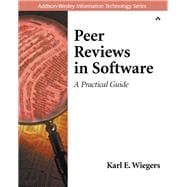Peer review works: it leads to better software. But implementing peer review can be challenging -- for technical, political, social, cultural, and psychological reasons. In this book, best-selling software engineering author Karl Wiegers presents succinct, easy-to-use techniques for formal and informal software peer review, helping project managers and developers choose the right approach and implement it successfully. Wiegers begins by discussing the cultural and social aspects of peer review, and reviewing several formal and informal approaches: their implications, their challenges, and the opportunities they present for quality improvement. The heart of the book is an in-depth look at the "nuts and bolts" of inspection, including the roles of inspectors, planning, examining work products, conducting code review meetings; improving the inspection process, and achieving closure. Wiegers presents a full chapter on metrics, and then addresses the process and political challenges associated with implementing successful software review programs. The book concludes with solutions to special review challenges, including large work products and software created by distributed development teams. For all developers, project managers, business analysts, quality engineers, testers, process improvement leaders, and documentation specialists.









